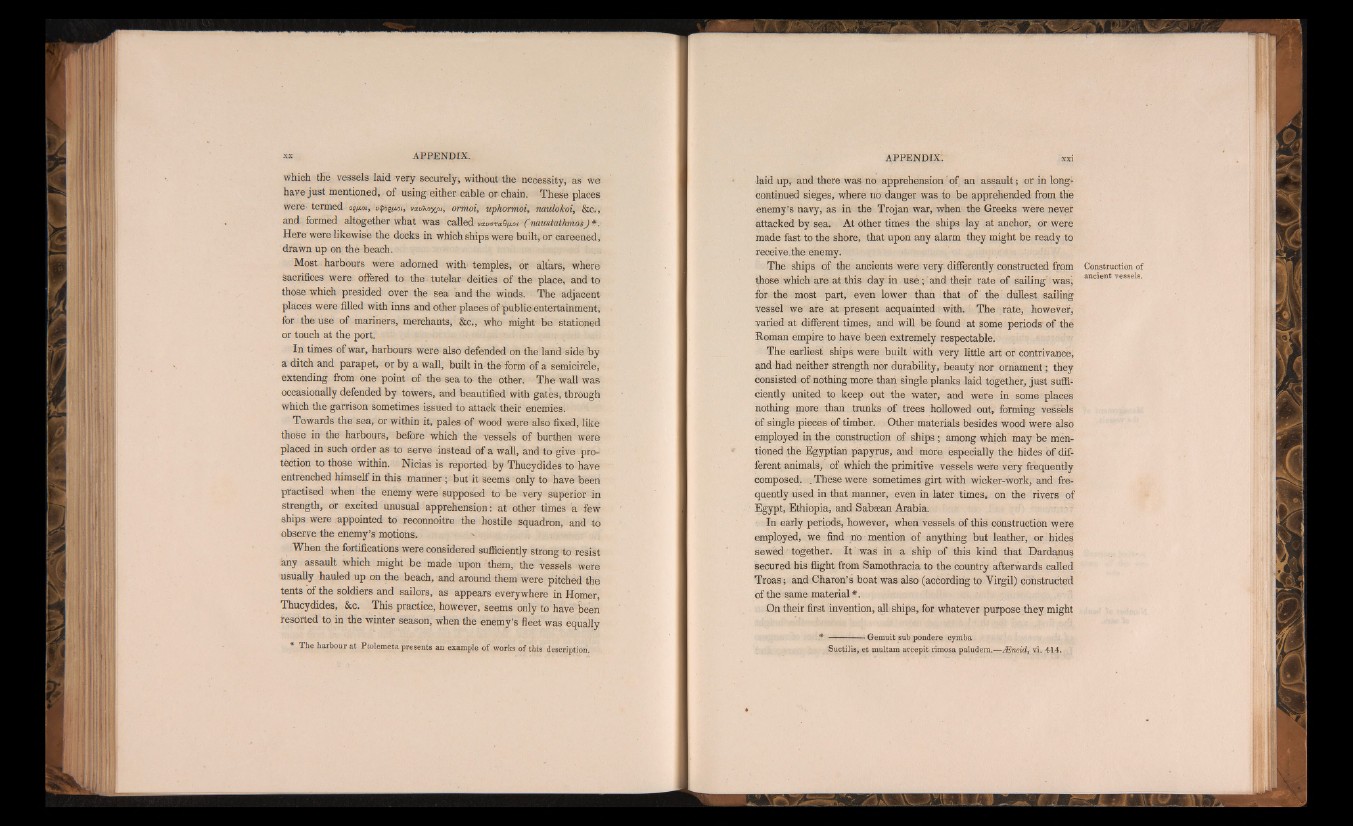
which the vessels laid very securely; without the necessity, as we
have ju st mentioned, o f using either cable or chain. These places
were- termed- o§/x<u, uQoqiaoi, vauXoxpi, ormai, uphormoi, naulokoi, &c..
and formed altogether what was called »«¡,«»8^05 (naustathmos) *.
Here were likewise the docks in which ships were built, or careened,
drawn up on the beach.
Most harbours were adorned with- temples, or altars, where
sacrifices were offered to the tutelar deities of the place, and to
those which presided- over the sea and the winds. The adjacent
places were filled with inns and other places of publie-entertainment,
for the use of mariners, merchants, &c., who might b e stationed
or touch at the port.
In times of war, harbours were also defended on the land side by
a ditch and parapet, or by a wall, built in the form of a semicircle,
extending from one point of the sea to the other. The wall was
occasionally defended by towers, and beautified with gates, through
which the garrison sometimes issued to attack their enemies.
Towards the sea, or within it, pales of wood were also fixed, like
those in the harbours, before which the vessels of burthen were
placed in such order a s to serve instead of a wall, and to give protection
to those within. Nicias is reported by Thucydides to have
entrenched himself in this manner ; but it seems only to have been
practised when the enemy were supposed to be very superior in
strength, or excited unusual apprehension: a t other times a few
ships were appointed to reconnoitre the hostile squadron, and to
observe the enemy’s motions.
When thè fortifications were considered sufficiently strong to resist
any assault which might b e made upon them, the vessels were
usually hauled up on the beach, and around them were pitched the
tents of the soldiers and sailors, as appears everywhere in Homer,
Thucydides, &c. This practice, however, seems only to have been
resorted to in the winter season, when the enemy’s fleet was equally
* The harbour at Ptolemeta presents an example of works of this description.
laid up, and there was no apprehension of an a ssau lt; or in long-
continued sieges, where no danger was to b e apprehended from the
enemy’s navy, as in the Trojan war, when the Greeks were never
attacked by sea. At other times the ships lay at anchor, or were
made fast to the shore, that upon any alarm they might be ready to
receive.the enemy.
The ships of the ancients were very differently constructed from
those which are a t this day in u s e ; and their rate of sailing was;
for the most part, even lower than that of the dullest sailing
vessel we are a t present acquainted with. The rate, however,
varied at different times, and will b e found a t some periods of the
Roman empire to have been extremely respectable.
The earliest ships were built with very little a rt or contrivance,
and had neither strength nor durability, beauty nor ornament; they
consisted of nothing more than single planks laid together, ju st sufficiently
united to keep out the water, and were in some places
nothing more than trunks of trees hollowed out, forming vessels
of single pieces of timber. Other materials besides wood were also
employed in th e construction of ships ; among which may be mentioned
the Egyptian papyrus, and more especially the hides of different
animals, of which the primitive vessels were very frequently
composed. . These were sometimes girt with wicker-work, and frequently
used in that manner, even in later times, on the rivers of
Egypt, Ethiopia, and Sabtean Arabia.
In early periods, however, when vessels of this construction were
employed, we find no mention of anything but leather, or hides
sewed together. I t was in a ship of this kind that Dardanus
secured his flight from Samothracia to the country afterwards called
T ro a s; and Charon’s boat was also (according to Virgil) constructed
of the same material *.
On their first invention, all ships, for whatever purpose they might
* —--------- Gemuit sub pondere cymba
Suctilis, et multam accepit limosa paludem.—Mneid, vi. 414.